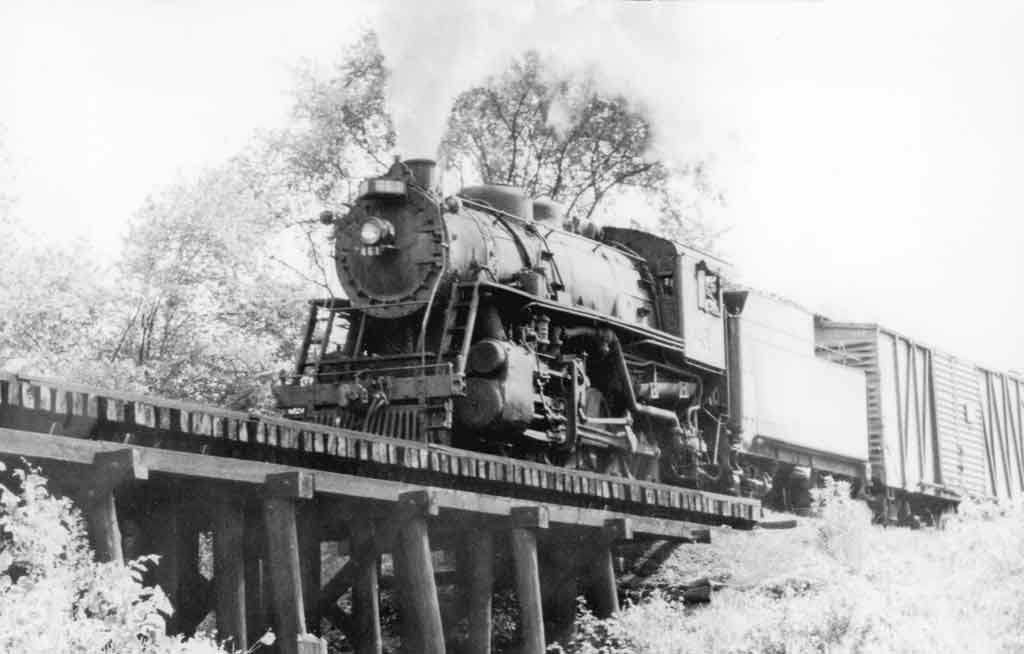My father, Bob Brittin, was CV’s agent at Montville, Conn., across the Thames River from the submarine base at Groton. One of CV’s customers, several miles north of the station, was United Nuclear Corp., which produced reactor vessels, primarily for the Navy’s expanding fleet of nuclear submarines. These extremely heavy, oversized shipments went to General Dynamics’ Electric Boat facility, also in Groton, as well as to U.S. Naval Shipyards at Newport News, Va., and Mare Island (Vallejo), Calif., on a government bill of lading.
The first three or four shipments were loaded at the Montville team track and typically took place in the late evening. The reactor vessels, which moved under the tariff description “heat exchangers,” were placed on lowboy trailers and moved by road through Uncasville, Conn., to the Montville station. That part of the move took several hours, as they were “walked” to the siding with a heavy Connecticut State Police and military guard. The last part of the move was down a steep hill to the station and team tack, and two tractors were used for braking, one at each end of the lowboy. A heavy crane was used to lift the reactors onto the special flatcar, and the entire team-track area was bathed in lights from portable generators, lending an eerie feel to the event.
Each shipment required a four-car special train, made up as follows: one empty boxcar (as buffer and spacer), one boxcar for component parts, one depressed-center flatcar for the reactor, and one passenger car for the guards who accompanied the shipments to destination. The passenger cars were converted Army hospital cars, fitted out with bunks and a galley, with special windows and compartments on the bulkhead ends to allow continual observation of the shipment in transit. The cars were staffed by a Navy officer and six enlisted personnel.
On the CV, motive power for these moves was usually one 460-series 2-8-0 (Alco, 1923; CV class M-5-a), plus a CV caboose. Given my “special status” as the son of the station agent, I usually was able spend time in the cab of the 2-8-0 with the CV crew, then sit in the passenger car and observe the loading process. I know that in addition to watching the proceedings and getting to stay up late, I was suitably impressed by the weaponry displayed by the friendly Navy guards . . . as well as their food buffet!
Since the CV portion was always only a short haul (Montville was only 6 miles from the New Haven Railroad interchange at New London), the moves did not generate a huge amount of revenue. In addition to special charges for the depressed-center flat (use and demurrage), other charges included demurrage for the “parts” boxcar, freight charges on the heat exchanger and component parts (at actual weight), a minimum of 10 regular coach fares for the guards, and a special-train charge of $7.10 per mile, with a minimum of 100 miles for each participating carrier.
For the transcontinental moves to Mare Island, the only through tariffs in existence for heat exchangers were via CV, parent Canadian National, and sister CN subsidiary Grand Trunk Western to Chicago, then via several Western carriers. For obvious security reasons, the government insisted that the reactor-vessel shipments had to move entirely within the United States, and on a specified routing over the New Haven from New London to Maybrook, N.Y., thence on the Erie to Chicago for Western connections. Since a “combination rate” had to be constructed, the result was a much higher overall cost than if the shipment had moved through Canada, even though the U.S. routing was shorter.
The team-track procedure didn’t last. After the initial moves, United Nuclear constructed its own spur at milepost 10.6, and all subsequent shipments originated directly from the plant. Because it was brought into the “clean room” for loading, the depressed-center flat was always steam-cleaned just outside the building prior to loading. Rather than having a crew on duty to await loading, CV called a caboose hop out of New London when the shipment was ready, and then moved the special train back to New London, where the New Haven had its engine, caboose, and crew ready at Union Station.
Several years later in the late 1950s, as a Cub Scout, I was also fortunate to have tours of the nuclear submarines Seawolf (after its record-setting submerged transit of the Atlantic) and Skate (after it had surfaced through the ice at the North Pole). Since the subs were fully operational, the reactor rooms were strictly off limits, but I always wondered if they harbored one of “my” reactors.
Today, the site formerly occupied by United Nuclear is a gambling casino. The Montville station was demolished years ago, Electric Boat is a shell of its former self, the submarine base in Groton is on the closure list, and the 2-8-0s that handled those atomic-age loads are long gone.
First published in Summer 2006 Classic Trains magazine.
Learn more about railroad history by signing up for the Classic Trains e-mail newsletter. It’s a free monthly e-mail devoted to the golden years of railroading.















Not to forget, little three foot gauge Rio Grande Southern operated trains that hauled uranium out of the Colorado Rockies which was sent to Los Alamos in New Mexico to aid in the development of the atomic bomb.